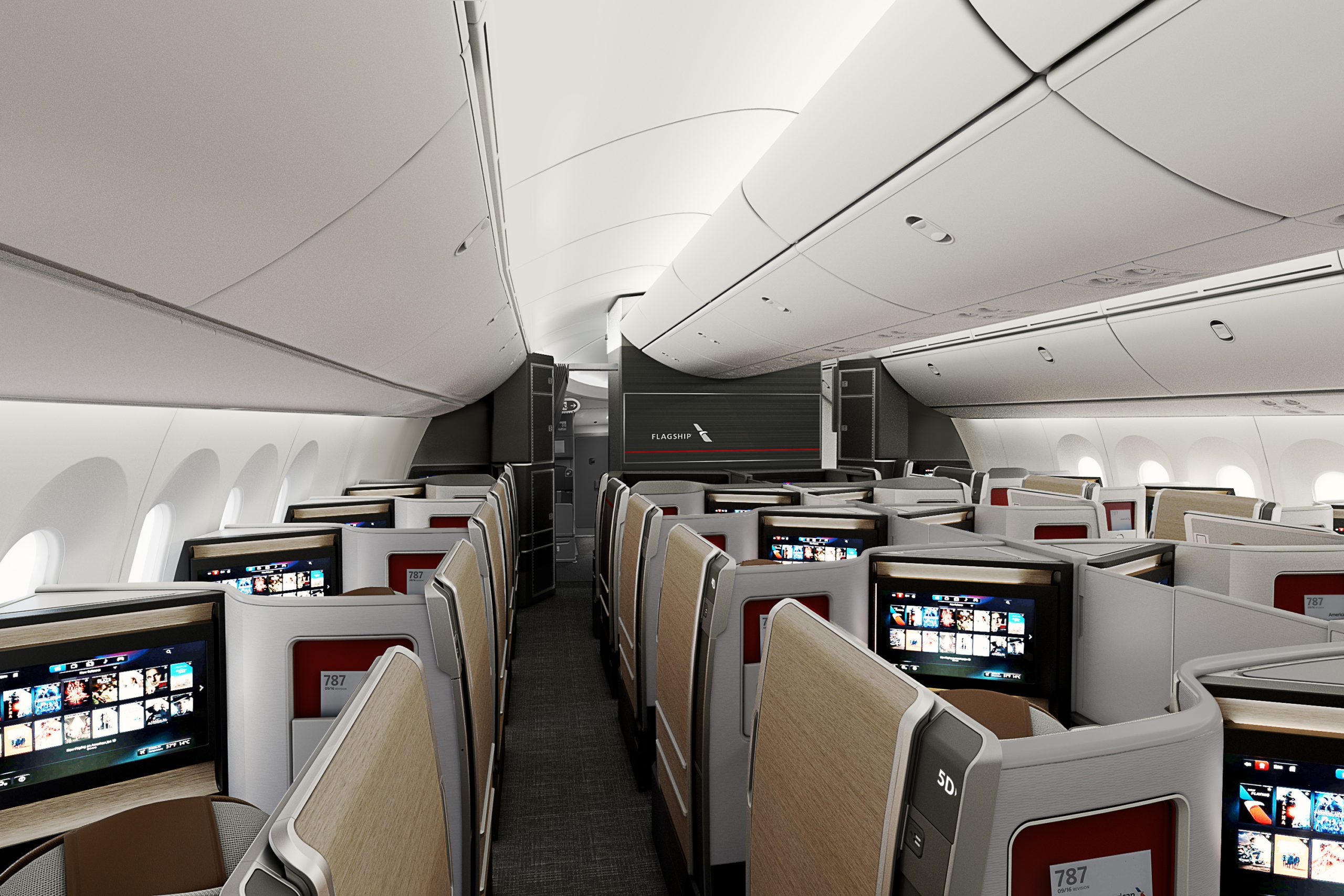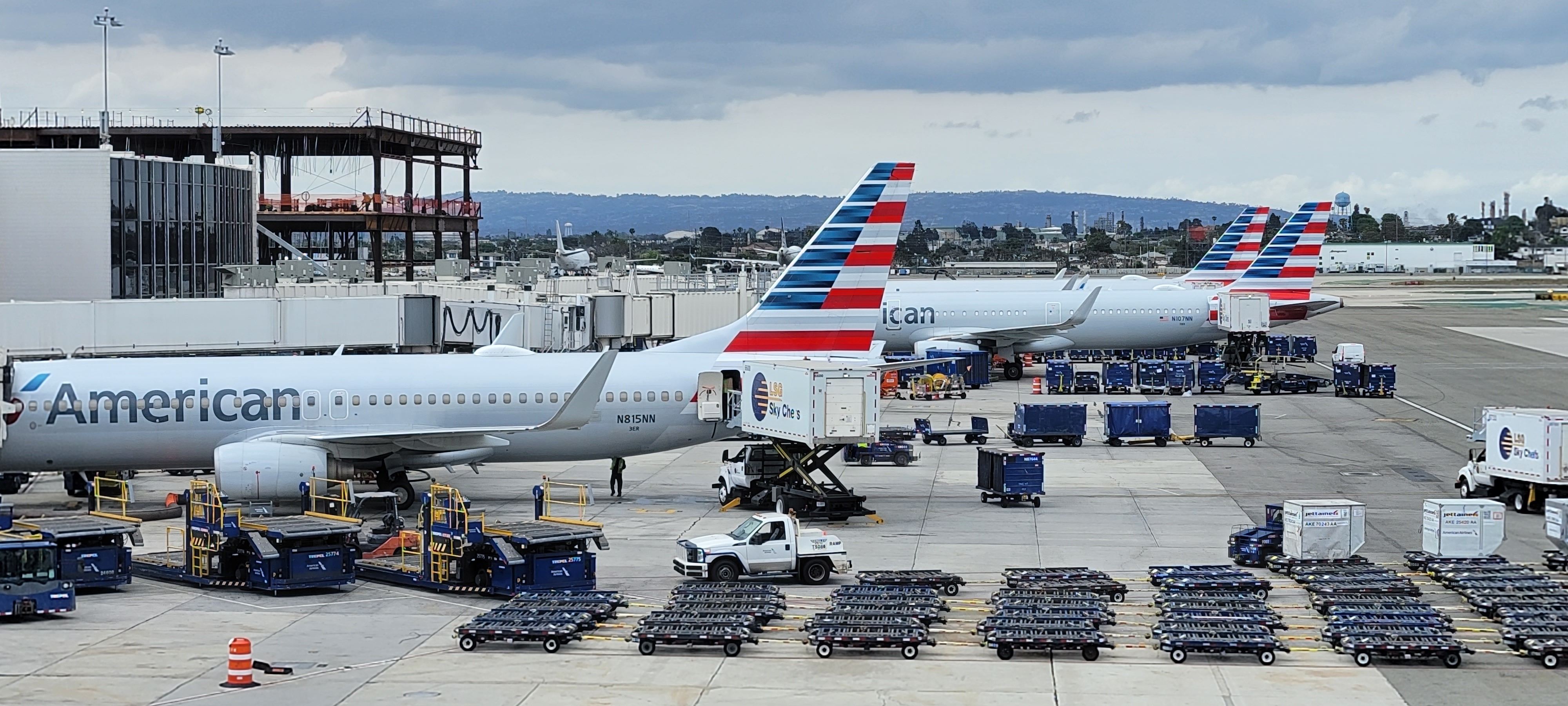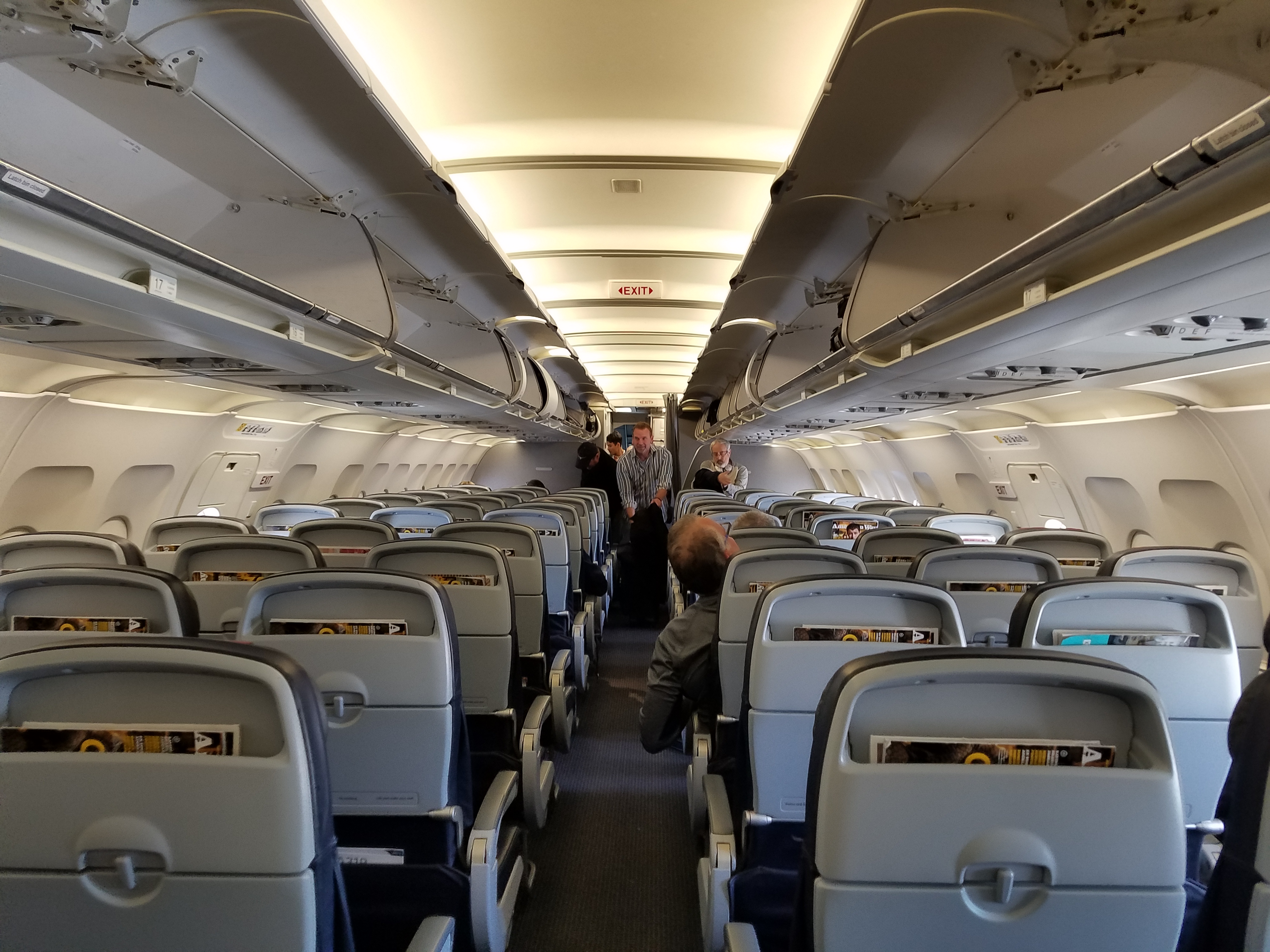Vasu Raja, American Airlines Chief Commercial Officer, appeared on the airline’s podcast for employees and laid out what he sees as their strengths and plans they’ll be pushing forward on.
His mantra is the customer, but not the product and experience, emphasizing that they “operate an airline [but] sell travel” and “selling travel is simple…building a great network, rewarding people for using it, delivering it well over and over again and executing efficiently.” He wants,
- a route network and schedule that gets people where they want to go, when they want to go there
- a reliable operation
- a rewards program that encourages customers to choose the airline
Missing from that is any discussion of the actual experience flying with American Airlines: friendly and helpful employees, quality lounges, onboard food and beverages. He’s long made the case for the schedule as the product.

New American Airlines Business Class Suites Are Coming, Credit: American Airlines
Chief Communications Officer Ron DeFeo who was interviewing Raja asked Raja about his emphasis on “the best domestic and short haul network.”
Raja explained (and Enilria transcribed) that the core of American Airlines is offering the best schedules for connecting passengers from small cities through their hubs to other cities domestically – and globally on American’s partners.
In many ways, it’s the core, it’s the foundation, it’s the heart of really all that we do as an enterprise…but then also when you look at the United States of America and just cut the country in half from the sunnier, warmer parts and the northern parts, well those northern parts have a lot of population…
They have big cities, big coastal cities. But in the southern part, what’s really started to change over the last couple of years is there we see the population growing and the economy growing and growing at a very considerable rate. But in all, in often cases, not necessarily just clustered around the biggest cities in the sunbelt. So for us, that is a huge opportunity. And frankly, it’s the source of our competitive advantage.
We, through frankly good fortune, have massive hubs that operate in the sunbelt. I think Phoenix, Dallas, Miami, Charlotte, two of the three largest mega hubs on earth are ours and they’re in the sunbelt.
But we also operate really large positions in these huge population centers like Chicago or New York or Philadelphia. Now that’s, like I said, a matter of good fortune, but where our advantage comes in is we can serve it uniquely in a way that no one else can.
We do it one through really large mainline jets. We’re talking the 321 Neo, the 737 MAX. We were the first people to go. We were upgauging before upgauging was cool, as we like to say, right?
But then on the other end, we have large regional jets, two class regional jets. And what those enable us to do is we are able to go and access a range of cities that many of our competitors just simply can’t because they don’t have the airplanes for it and connect them to the globe.
So what that means is a practical matter is of the, let’s call it 300 cities or so that we serve in North America in 200 of them, we offer a better scheduled customers that are there.
And so that means that our domestic system is bringing in customers who are then able to go fly international and participate in advantage and do a bunch of things…

While American is so focused on flyover country, they augment this by feeding passengers back and forth with British Airways, Japan Airlines, Gol, and Alaska.
The core is a great short haul network, domestic, Mexico, Caribbean, Latin America. That’s our great short haul network. What that’s enabled us to do is go and build a set of partners who themselves have access to really important, sizable, high growth customer bases, whether that’s in London or Tokyo or more recently in Seattle or Doha or Sao Paulo.
What our partners bring to us is more access to more customers, but what they benefit from and frankly why they value us so much is this unique domestic system, the short haul system that we have because there’s nobody else in the world who can go and bring that customer base.
We don’t have an airplane long enough to go fly into the South Pacific in some cases. It enables us to go put together a long haul network that makes sense for our customers, that makes money for us, that is vibrant and growing.
The thing that people tend to see is a long haul network. We fly into Doha or to London or to Buenos Aires. And we are going to grow that. We are going to grow that in a profitable way on a mix of 87s, triple 7s, 321s. But then behind that is a partner network that enables it and feeds customers to it. But at the very heart of that doll, the central heartbeat of it is our short haul network.

This isn’t a new message from Raja. Enilria interprets it to mean American is focused on short haul flying from its hubs, “focused much more on fly-over America than Delta or United” with long haul more of an afterthought focused on partner hubs.
There’s definitely a bias towards lots of small ball wins, rather than taking expensive chances with widebody flights over long distances. They want narrowbody frequencies flying domestic routes, supported by connections through Dallas and Charlotte.
Tactically, American is approaching this by:
- “Productiz[ing travel] in an infinite number of ways”
- Focusing on “AAdvantage and our credit card programs” so that customers “can always access travel….people are always thinking about travel” with American. He wants to “give people more miles, at a cheaper price, enable more redemption that ever before.”
- Leveraging revenue management, where American isn’t alone but was first decades ago (“machine-learning before machine learning was cool, a massive system to forecast demand, [which] has become extremely accurate over time). I’d argue that American’s revenue management has been forecasting to sell more seats at higher fares than customers have been willing to buy, and that this has hurt their load factors and chased premium passengers to other airlines selling front cabins for less.
- Eliminating travel agencies, “going direct to the customer.” He’s overclaiming the airline’s digital abilities, for instance it is not possible to confirm an upgrade online using miles or systemwides and the only confirmable upgrade the airline had – Business ExtrAA – has been eliminated.
[American has] greatly invested in digital servicing. As of the end of this year, virtually anything you buy in the domestic U.S. that’s from American Airlines, not through a travel agency, you can service through the app. We’re the only people who can go and do that.
Raja claims that selling travel through agents often “introduces more complication” so they’ve “gone away from distribution strategies and technologies that effectively drive expense to our customers, that don’t create a servicing advantage, that don’t enable them to truly go experience the magic of air travel and we’re encouraged by the results so far.”

American continues to double down on walking away from high touch servicing of managed corporate contracts, and working with travel agencies who sell air. They’ve bet that they don’t need to discount to fill planes, which may be true in Dallas and Charlotte and Miami. But losing this business may hurt in an inevitable economic downturn. Other airlines have been happy to pick up what American has walked away from, and better agencies would argue it’s American that “introduces more complication” and that’s made it harder for them to untangle those messes that the airline creates.


This is the more interesting part of the discussion than the loyalty program part because the loyalty program simply flows from an airline’s strategy.
As for some of its claims, Airlines for America just updated their datapack on Dec 20 which includes average aircraft size by carrier and breaks out regional vs. mainline aircraft.
AA has the same average aircraft size for domestic departures as UA at 123 while Delta is at 135 (higher than Alaska), JetBlue is at 149 and Southwest is at 159.
AA does have the largest mainline gauge at 169, just one over UA while DL is at 164 but the difference comes down to the percentage of flights that are operated by mainline where DL is at 66, AA is at 53 and UA is at 56%.
All of the airlines report their consolidated financial results including regional jets and AA is just less efficient at moving passengers than UA and esp. DL and that does impact their financial results.
Vasu also talks about the number of connection possibilities and AA’s multiple hubs do create more connection opportunities but they don’t have more actual seats than DL and that is apparent from the gauge statistics.
AA wants to be a high volume, lower fare carrier but they use a whole lot of less efficient regional jets and that will forever drag down their financial results until they get the right planes for the strategy they are attempting to pursue.
Funny AA thinks they offer the most robust domestic network but yet for a ton of itineraries the only option is to double connect or pay exorbitant prices (i.e. $800+ for economy) to book the only 2 or 3 one stop options. While on UA/DL there are more options through multiple hubs.
Phoenix (no longer an option for many non hub/focus city points on the east coast) has been gutted so has Philadelphia. Chicago has seen cuts and now often only has two real connecting banks.
It’s a struggle flying AA and I have to be willing to look at 5-6 airports in my area to get the best schedule. I am only hanging on EXP by a thread and I have started finding myself shopping different airlines now.
SW from DAL starts to look very good relative to AA from DFW if I don’t get full points by using my (employer-mandated) travel agency.
AA’s problem is, well, AA. They’re ambitious and they’re stupid and that makes for a disastrous combination.
They just don’t do anything particularly well and their financial outlook speaks to it. I know folks love to hate on Delta, sometimes rightfully so, but Delta does get things right (or close to it) more times than they flat out get it wrong.
As for AA, the same can’t be said. Pick at any part of AA’s operations and finance and one would be hard-pressed to find anything that they do particularly well when compared to their competitors.
They focus on domestic network feeding international partners, yet it keeps getting worse and worse trying to find saver level connections to partner flights
AA in a nutshell, 16 minute and 31 second podcast; not a single word or mention about customer service.
Tells you what they think as an airline that sells “travel”.
Southwest figured it out 50+ years ago, as a customer service company that operates airplanes.
Bob,
the chances are high that WN will start DFW service and perhaps elsewhere in the Metroplex when AA and WN are freed from their respective N. Texas airports in 2025.
Another way to spin Raja’s speech is that AA cannot compete in major cities so it has to compete in smaller markets in the sunbelt.
It cannot compete against foreign carriers so it must partner with some of them.
AA does one thing well, being a carry on bag nazi and being totally inflexible about leaving the gate early.
What?…no mention of their NYC strategy. Oh yea, there isn’t one.
The picture doesn’t look anything like a shopping portal or a hotel. Confusing to say the least…
If I were to put together a word cloud of things I didn’t hear in those 16 minutes…it would include these things:
-Customer Service
-Quality Product
-Empowering team members to deliver quality
-Tools to delivery top notch service
-Service standards on-board
-Valuing the customer
-Superior soft product and hard product
This is disappointing. It seems to me they are trying to be no better than Southwest or Spirit – but with a broader domestic network. Why choose American – because you like their frequent flyer program and they have a lot of planes with lots of seats to lots of (US) places to let you use your miles.
This is not the formula to secure a revenue premium to enable you to pay back all the money borrowed to fund the misguided strategy to buy back shares.
These folks clearly have been talking amongst themselves too much and think they have it all figured out. Perhaps they need to fly the premium cabins of their partners and competitors and see what it takes to deliver a premium product clients will happily pay for.
I guess things won’t change at American until they face another reorganization through the courts to force some fresh thinking.
I feel like Vasu and his fellow US Air execs have been claiming to be putting this strategy into place since they merged in 2013. And they keep talking about it like it’s just about to pay off… but it never does. Like, when does the strategy start working? It’s been 10 years… your stock price is $13 and analysts say it’s overvalued.
@Steve The NYC strategy is the appeal to save the NEA. Once the case is decided, AA will be able to look at its options. Anything else is premature.
> Considers Doha a major hub
@ Gary — So to summarize, US Airways lives on. Management has destroyed all things AA and turned the airline into US II by running a heavily government-subsidized feeder network to its alliance partners and by selling miles and alliance awards cheaply. Works for me since I have considered moving to one of those small towns and have a bazillion AA miles! This strategy may even work for a while with the rise of so many Zoomtowns.
All three of the majors have risky “going forward” strategies. United’s is the riskiest, betting heavily on a return of premium international business travel. American’s, while small ball and domestic heavy, seems the safest.
These last two posts are extremely useful, as AA is 100% toast; there’s no turnaround in the future, only more of the same. I am now looking for another program to collect points for my QR, JL, and CX flights: any candidates/suggestions?
Actually, Gary, you should write a post suggesting where us rats fleeing the sinking ship should end up — it’ll have some really good readership!
@Jake – depends on how much total flying you’re doing and how much is in the U.S.? Alaska’s Mileage Plan is still a strong program, and their elites get full reciprocity flying American. The fare classes you’re flying matter too.
Brian W,
AA has said it isn’t really trying to save the NEA with its lawsuit since B6 isn’t interested in it any longer. AA is trying to preserve the potential for similar arrangements in the future but the courts have repeatedly said they won’t rule on future deals.
Gene,
you highlighted why you continue to be frustrated and never able to contribute to discussions because it is always all about you.
JetAway,
UA’s strategy is the riskiest because of the amount of capex they have = multiples more than AA spent that landed them with the highest debt load for over a decade.
UA is finally making money in all regions of the world but it is DL that is making more money and doing it by spending less money – and that will continue.
And UA’s strategic risk is thinking that they can grow their domestic network in markets where AA DL and WN are all larger and where ultra low cost carriers take share.
AA’s risk is that they still can’t deliver revenue to cover their high costs and get acceptable returns – which is why their stock is still low.
AA’s strategy of being HP or US 3.3 might work IF they can get costs out – but they haven’t been able to do that in 15 years.
Look for a fresh chapter 11 coming soon. Would void all contracts. Part of their master plan.
Vasu and all this US Air execs need to be fired. They had taken the AA brand down the toilet.
@H.Keller – Vasu is, in fact, legacy American Airlines for what it’s worth
If I ever needed a reason to shift to Star Alliance for my international travel, which is mostly what I do, this is it.
Sky Team? I’ll need to sign up for Flying Blue and avoid disgusting DL as much as possibe.
It’s funny that he mentioned São Paulo. The GOL partnership is deeply underwhelming. No free checked bag or lounge access for AA elites, miles from GOL flights don’t reliably credit… It sure doesn’t feel like a partnership that AA management is prioritizing.
Having come out of an agency environment for 30 years and a former owner I would have to say that if I was now in the business I would be ensuring that AA plate was long gone from my agency. Talk about arrogance. I recall a few startups in the 90s thinking they could avoid using agencies and they quickly realized how important and integral agencies can be to their bottom line. Walking away from corporate is just stupidity. I didn’t think there was a CEO as dumb as this one but man he takes the cake.